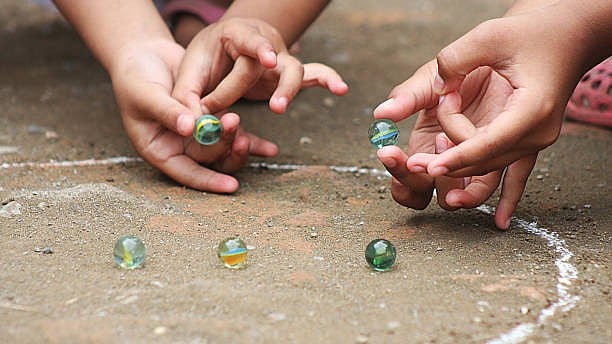
When we were children, some 55-60 years ago, we played what are now known as desi games — gilli-danda, marbles, and buguri or spinning tops.
Credit: iStock photo
When we were children, some 55-60 years ago, we played what are now known as desi games — gilli-danda, marbles, and buguri or spinning tops. These were games for everyone, for they cost little or nothing. Each had its own charm and tested both body and mind.
Gilli-danda required skill and strength. The player—much like a batsman in cricket—struck the gilli, a small piece of wood with tapering ends, using the longer stick, the danda. The goal was to hit the gilli as far as possible and then repeat the act from where it landed. The player who sent it the
farthest was the winner; if an opponent caught the gilli mid-air, the striker
was ‘out’. The game strengthened
the arms and legs.
The marble game, on the other hand, tested one’s focus and aim. A player used a marble, flicked with the middle finger, to hit a line of marbles placed at a distance. Points were scored based on how many marbles were displaced with each flick. The game sharpened precision and focus—much like archery and shooting.
The game of spinning tops had two levels of mastery. First, one had to wrap a string around the top, release it with force, and catch the spinning top on the palm—not an easy feat, I promise! The second was trickier still: to release the top so it struck another top placed on the ground—either directly or after spinning it on the palm—and its success was judged by the dent it left.
My claim to fame, modest though it may be, is that I excelled in all these desi games and was perhaps unbeatable in the mohalla where I lived.
Had these been Olympic sports, I daresay I might have had a shot at ending India’s medal drought.
These desi games were largely male-dominated then; girls had their own set of games — tennikot (or ring), chowka-bara (similar to present-day Ludo), kunte-bille (hopscotch), skipping rope and kho-kho, which in those days was played only by girls.
The beauty of the desi games lay in their inclusiveness. Children from every background—rich or poor, upper or lower caste, regardless of religion—played together. There were no barriers.
Sadly, these games have vanished from our parks and streets, replaced by screens and smartphones. The new addictions may offer excitement, but they come at the cost of physical play and social bonding.
Even today, when I walk past parks, open spaces or empty grounds, I feel a pang of nostalgia. I still have the urge to play a round of gilli-danda or spin a top. But alas, there are few takers now.